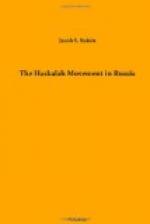In his inimitable manner Gibbon describes the fierce struggle the Greek Catholic Church had to wage before she obtained a foothold in Russia, but he neglects to mention the fact that Judaism no less than paganism was among her formidable opponents. The contest lasted several centuries, and in many places it is undecided to this day.[15] The Khazars, who had become proselytes in the eighth century, were constantly encroaching upon Russian Christianity. Buoyant as both were with the vigor of youth, missionary zeal was at its height among the two contending religions. Each made war upon the other. We read that Photius of Constantinople sent a message of thanks to Archbishop Anthony of Kertch (858-859) for his efforts to convert the Jews; that the first Bishop of the Established Church (1035) was “Lukas, the little Jew” (Luka Zhidyata), who was appointed to his office by Yaroslav; and that St. Feodosi Pechersky was fond of conversing with learned Jews on matters of theology.[16] On the other hand, the efforts of the Jews were not without success. The baptism of the pious Olga marks an era in Russian Christianity, the beginning of the “Judaizing heresy,” which centuries of persecution only strengthened. In 1425, Zacharias of Kiev, who is reputed to have “studied astrology, necromancy, and various other magic arts,” converted the priest Dionis, the Archbishop Aleksey, and, through the latter, many more clergymen of Novgorod, Moscow, and Pskov. Aleksey became a devout Jew. He called himself Abraham and his wife Sarah. Yet, strange to say, he retained the favor of the Grand Duke Ivan Vassilyevich, even after the latter’s daughter-in-law, Princess Helena, his secretary Theodore Kuritzin, the Archimandrite Sosima, the monk Zacharias, and other persons of note had entered the fold of Judaism through his influence.
The “heresy” spread over many parts of the empire, and the number of its adherents constantly grew. Archbishop Nikk complains that in the very monastery of Moscow there were presumably converted Jews, “who had again begun to practice their old Jewish religion and demoralize the young monks.” In Poland, too, proselytism was of frequent occurrence, especially in the fifteenth and sixteenth centuries. The religious tolerance of Casimir iv (1434-1502) and his immediate successors, and the new doctrines preached by Huss and Luther, which permeated the upper classes of society, rendered the Poles more liberal on the one hand, and on the other the Jews more assertive. We hear of a certain nobleman, George Morschtyn, who married a Jewess, Magdalen, and had his daughter raised in the religion of her mother. In fact, at a time when Jews in Spain assumed the mask of Christianity to escape persecution, Russian and Polish Christians by birth could choose, with little fear of danger, to lead the Jewish life. It was not till about the eighteenth century that the Government began to resort to the usual methods of eradicating heresy.




